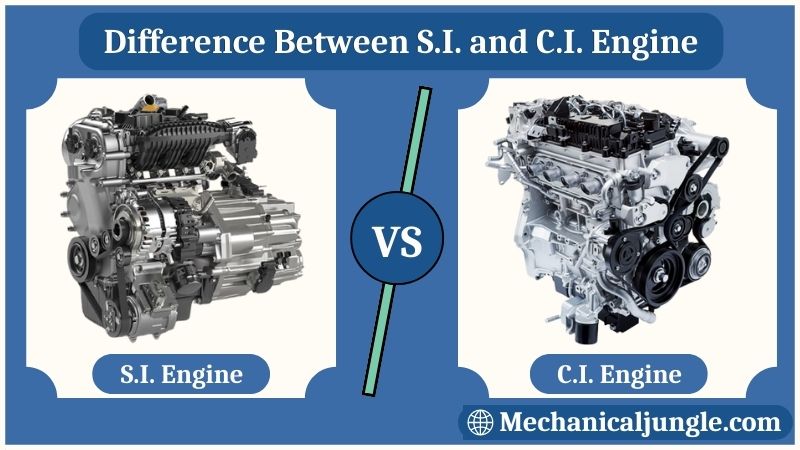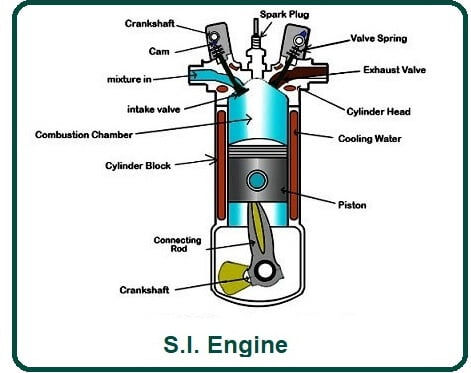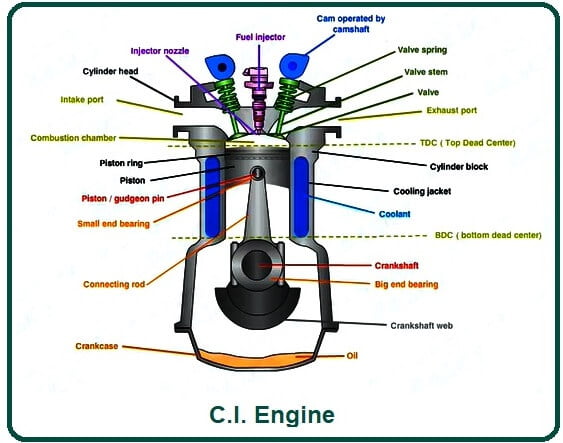Important Point
What Is Spark Ignition Engines (S.I. Engine)?
The Spark Ignition Engines is a petrol engine often used on commercial vehicles such as scooters, motorcycles, cars, etc. It produces less noise and vibration, is easier to start, requires less maintenance, and has lighter weight. In their definition, we can say that S.I. engines are internal combustion engines that operate on the principle of spark ignition (which is to create a spark with a spark plug).
It uses petrol and fresh air to complete the Otto cycle. The four-stroke petrol engine performs the work cycle in four stages. During that time, the crankshaft takes two turns. The first cycle is intake – the clip goes from TDC (top dead center) to BDC (bottom dead center), and the suctions valve starts to open before the piston reaches TDC and closes after the piston passes the BDC position.
A pressure of 0.7–0.9 bar is produced in the cylinder, which, through an open valve, draws a freshly worked mixture that is mixed into the cylinder with the remaining combustion products from the previous process. During compressions, the clip moves to TDC and compresses the gases in the cylinder. Pressure increases from 11 to 18 bar and temperature from 400 to 600 0C. The piston-cylinder starts to reduce chamber space.
Both cylinder valves are closed, and fuel and air compression is performed. Combustion starts before TDC and lasts until BDC. Compression ratio values range from 6 to 11. During expansions, the compressed fuel and air mixture is ignited by an electric high-voltage spark plug just before the piston returns to the TDC position.
At the beginning of the expansion stroke, the pressure of the combustion gas is 40–60 bar, and the temperature is 2000–2500 C. Due to the pressure of the high combustion, the pistons move from TDC to BDC, where useful mechanical works are achieved. By increasing the volume of the cylinder & the expansion of the combustion gases, the pressure and the temperature of the combustions gas is reduced, leading to 3-5 times the pressure of the combustion gas at the end and the temperature 700–1000 C. Due to exhaustion the piston moves from BDC to TDC and then exhales cylinder gases through an open exhaust valve.
The combustion gases have a pressure of 1.05 to 1.20 bar. Depending on the cylinder charge, the pressure at the front and rear of the exhaust may be above critical, & a good part of the gas is ejected due to the pressure difference. The high pressure and temperature in the engine cylinder represent an important precondition for achieving high efficiency. At full engine powers, the exhaust gas temperature is about 700–1000 C.
What Is Compression Ignition Engines (C.I. Engine)?
The compression ignition engine is a diesel engine used in heavy vehicles, machinery, railways, ships, trucks, and equipment. In the combustion process, unlike the SI engine, only air enters the cylinder during the suction stroke, which allows both air and fuel to enter. It ignites diesel fuel with compressed hot air. CI engine is also internal combustion engines that use diesel fuel to run on a diesel cycle.
In the system, the spark plug is terminated because the spark does not require combustion. The combustion is accomplished by compressing the air purified in the cylinder, which is then compressed to a warm temperature to ignite when the fuel is injected. This system has a high compression ratio due to the high ignition temperature of diesel fuel.
Higher compression ratios produce more power. Incomplete combustion produces more hydrocarbons, causing air pollution from the exhaust. The first phase (intake) begins by opening the suction valve. The clip moves from TDC to BDC, causing the pressure in the cylinder to rise as the volume increases above the piston so that the actual cylinder pressure is 0.7 – 0.85 bar during the suction time. In the case of the turbocharged engine, it is up to 2 times.
The second stroke (compressions) begins by closing the suction valve & ends at TDC. The capacity of the injected working medium in the compression chamber is reduced by 14 to 24 times. The air pressure at the end of compression is 30 – 60 bar, and its temperature is 600 – 9000C. After compression of air, expansion begins, and fuel is injected into the cylinder with pressures of 90 – 2000 bar, depending on injection devices.
The fuel is dispersed, heated, mixed with air, & ignites. During combustion, the temperatures rise to 2000 – 25000C & the pressure to 60 – 120 bar. In this trick, the piston mechanism has maximum mechanical and thermal stresses. During expansion, the clip is changed from BDC to TDC, thus the clearance of the cylinder through the exhaust valve. The pressure at which exhaust gases pass is 1.05 to 1.20 bar. The temperature of the gases is 500 – 6000C.
Also, Read: Coal-Fired Power Plant | Working of Coal Power Plant | Main Components of Coal Power Plant
Difference Between S.I. and C.I. Engine:
| Sr. No. | Spark Ignition Engine (S.I Engine) | Compression-Ignition Engine(C.I Engine) |
| 1 | S.I. engine is called the spark-ignition engine. | C.I. engine is called a compression ignition engine |
| 2 | S.I. engine fuel is used as petrol, so this engine is also called the petrol engine. | The fuel used in C.I. engines is diesel, so it is also called a diesel engine. |
| 3 | The S.I. engine was developed by otto in 1862 | The C.I. engine was developed by Rudolf diesel in 1892. |
| 4 | S.I. engine fuel mixture is homogeneously used | The mixture of C.I. engines is heterogeneous. |
| 5 | In si engine inlet valve, suction of air and petrol mixture | The Inlet valve of the ci engine is the suction of only air. |
| 6 | The ignition of the S.I. engine is due to the spark plug. | Ignition produces in a diesel engine is auto-ignite. Fuel is injected into the cylinder under high pressure. |
| 7 | The combustion of a petrol engine is smooth. | Combustion of C.I. engine not smooth it is noisy. |
| 8 | The compression ratio of the si engine is low up to 5 to 10 | The compression ratio of the C.I. engine is high it upto 15 to 25. |
| 9 | The maintenance problem is less in the S.I. engine. | Maintenance is high required. |
| 10 | The thermal efficiency is low of the si engine compared to the ci engine. | The flywheel required of the si engine is large size requires compared to the si engine. |
| 11 | The flywheel size requires small compared to the ci engine. | Thermal efficiency is high in the C.I. engine compared to the si engine. |
| 12 | The space required for the S.I. engine is small. | More space required of ci engine compared to S.I. engine. |
| 13 | Construction of si engine is lighter and cheaper than ci engine | The construction of the C.I. engine is heavier and bulky. |
| 14 | The vibration creates in si engine is low | Vibration in the C.I. engine is more. |
| 15 | Fuel efficiency less | Fuel efficiency is high. |
| 16 | Specific output is less. | Specific output is high of the C.I. engine. |
| 17 | The piston shape of the S.I. engine is convex. | The piston shape of the C.I. engine is concave. |
| 18 | Pollution is high of si engines compared to the ci engine | The pollution produced of the ci engine is less. |
| 19 | The power output of the S.I. engine is less. | Power output is high of C.I. engine. |
| 20 | Air fuel ratio 15:1 | The Air fuel ratio of the ci engine is 18 to 70 |
| 21 | The cost of the S.I. engine is less. | The cost of the C.I. engine is high. |
| 22 | The running cost of the S.I. engine is less. | The running cost of the C.I. engine is low compared to the si engine. |
| 23 | The speed of the S.I. engine is high. | The speed of the ci engine is low. |
| 24 | Noise produces in si engine is less | Noise produces in the C.I. engine is high. |
| 25 | Preignition chance high in si engine | Preignition has less chance to create in the ci engine. |
| 26 | The mixture required of si engine is rich | The mixture required for the C.I. engine is lean |
| 27 | The exhaust temperature of the S.I. engine is high compared to the C.I. engine. | Exhaust temperature low of ci engine. |
| 28 | Overheating trouble is more in the si engine. | Overheating problems are less in C.I. engines. |
| 29 | Press6at end of compression is 10 bar. | The pressure at the end of compression in ci is 35 bar. |
| 30 | Starting problem is not in the S.I. engine. | Starting problem is created in the C.I. engine. |
| 31 | S.I. engine used in the light-duty application. | I am used to C.I. engines in heavy-duty applications. |
| 32 | Delay periods of the si engine are 0.002sec | Delay periods of the C.I. engine are 0.0002 sec. |
| 33 | Ignition produces at constant volume. | Ignition of the C.I. engine is at constant pressure. |
| 34 | Fuel consumption per B.P is 0.25 kg. | Fuel consumption per B.P is 0.20 kg. |
| 35 | Quantitative governed used in si engine. The fuel varies with respect to load is air+fuel. | Governor use of C.I. engine is qualitative governed fuel caries with respective to load is fuel. |
Also, Read: What Is a Hydro Power Plant? | Working of Hydropower Plant | Types of Hydropower Plants
Advantages of S.I. Engine:
- It produces less noise
- The engine is light
- Less maintenance is required.
- It starts easily
- High speed and thermal efficiency.
- Cheaper
Advantages of C.I. Engine:
- Produces more power
- High work efficiency
- Huge amounts of fuel can be burnt
- Low fuel cost
- High energy density
- Good lubricating properties
- Low risk of fire due to non-production of flammable vapor.
- Good exhaust-emission behavior.
- No intake of air restriction other than an air filter.
- Fuels are injected directly into the combustion chambers.
Also, Read: Top 10 Mechanical Companies in USA 2021
Disadvantages of C.I. Engine:
- Make more noise and vibrate.
- Produces hydrocarbons, causing environmental pollution.
- Higher maintenance costs are required.
- The engine is heavy.
Frequently Asked Questions (FAQ)
What Is Spark Ignition?
A spark ignition (SI) engine is an internal combustion engine, usually a gasoline engine, in which the combustion process of the air-fuel mixture is ignited by a spark from a spark plug.
What Is Compression Ignition Engine?
In a compression ignition engine, only air or air plus residual combustion gases from the exhaust, known as exhaust gas recirculation (EGR), is inducted into the chamber during the intake stroke and compressed during the compression stroke.
Difference Between SI and CI Engine
The Spark Ignition (SI) engine, as its name indicates, uses a spark to ignite the fuel. And in Compression Ignition (CI) engine, the air is compressed within the cylinder, and the heat of this compression air is used to ignite the fuel.
SI Engine
In the SI engine, ignition is induced by sparks generated by spark plugs, where the operation cycle is adjusted to the engine speed and load using mechanical or computer-controlled ignition systems.
CI Engine
A CI engine is an engine in which the fuel charge is ignited by the heat of compression. The process of combustion in the CI engine is fundamentally different from that in a spark-ignition engine.
Like this post? Share it with your friends!
Suggested Read –
- What Is a Spark Plug
- Parts of a Solar Panel
- Vapor Compression Cycle
- How Often Diesel Oil Change
- Domestic Electrolux Refrigerator | Different Components of Domestic Electrolux Refrigerator
- Types of Angle Plates | Box Angle Plate of Angle Plate | Swivel Angle Plates of Angle Plate | Cast Iron T-Slotted Angle Plate of Angle Plate
- What Is Wilson-Hartnell Governor? | Wilson Hartnell Governor | Construction of Wilson Hartnell Governor | Working of Wilson Hartnell Governor
- Cochran Boiler | Cochran Boiler Working | Working Principle of Cochran Boiler | Applications of Cochran Boiler | Advantages & Disadvantages of Cochran Boiler
- What Is Cupola Furnace? | Cupola Furnace Design । Cupola Construction | Purpose of Cupola | Working Principle of Cupola Furnace: | Advantages of Cupola Furnace | Disadvantages of Cupola Furnace | Applications of Cupola Furnace




Leave a Reply